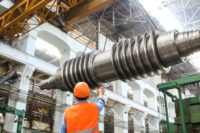Be aware of accessibility and safety concerns in industrial spaces

According to OSHA statistics, 5,333 people died on the job in 2019 alone due to a workplace accident. With numbers like these, addressing accessibility and safety concerns in industrial spaces is vital. Companies must work to keep their employees safe and secure on the job to prevent unrecoverable tragedies and mitigate liability costs.
Unfortunately, many businesses fail to understand the importance of reassessing safety standards to accommodate diverse workers and their various needs. Securing an industrial space means adopting considerate and accessible safety practices — no matter the worker’s ability.
Here, we discuss the importance of addressing these concerns and offer strategies you can employ to improve both the accessibility and safety of your own industrial operation.
The importance of re-assessing your safety standards
While you no doubt have standards in place to comply with OSHA requirements and best secure employee safety, the changing workforce and technological advancements mean there is always more that you can do to improve safety outcomes. Because the sad reality is that workplace injuries are still far too common.
In fact, data shows that in the United States alone, a worker is injured every seven seconds. In turn, this leads to problematic statistics like the following:
- 99 million days of lost productivity per year
- 21 days of disability on average per injured worker
- $170 billion in direct financial costs per year
But the financial aspect is the least important consequence of dangerous workplace practices. Human life is irreplaceable, and devastating accidents can cause long-term health problems even when they don’t result in tragedy. Being cognizant of the accessibility and safety accommodations you can make in an industrial space can help your business mitigate these horrible consequences while showing workers that they work in an environment that considers their needs and wellbeing.
By addressing accessibility and safety concerns, your business can cut costs, promote inclusion, and even save lives. With these benefits on the table, now is the time to reassess your safety standards.
Addressing accessibility and safety
The Americans with Disabilities Act (ADA) provides legal requirements for reasonable accommodations for disabled workers in any workplace. These are standards that you have to meet to avoid penalties. However, going beyond the mandates of ADA compliance to address the needs of a diverse workforce can help secure both safety and productivity.
First, it's important to understand that disability does not mean a disadvantage. The Job Accommodation Network (JAN) has found that various benefits are associated with hiring individuals with disabilities and supporting them with the proper accommodations. These benefits include:
- Increased employee retention
- Better company morale
- Increased productivity
- Greater levels of safety
- Increased employee attendance
Creating an industrial space that accommodates the needs of workers with disabilities can lead to all these benefits and more. But first, you need the equipment and practices for the job. For example, emergency showers and eyewashes should meet ADA standards by being functional for all kinds of users. This includes being adjustable for wheelchair access.
Additionally, you need to consider disabilities that are too often neglected. Color blindness, for example, affects 1 in 12 males and requires thoughtful use of color in signage and space organization. Without an accessibility-focused approach to industrial safety, businesses are liable to face slip-and-fall lawsuits and other legal troubles from a poorly optimized workplace.
With the advancements of modern technology and artificial intelligence, accommodations to reduce risk are more accessible than ever. If you feel that you cannot possibly address every risk factor in your space, tech is here to help. With a connected factory model, you can build self-monitoring equipment that alerts workers to potential malfunctions and accidents. At the same time, you can even automate the most dangerous of tasks with the help of robotics to promote greater levels of safety.
Secure your accessibility and safety accommodations making the most of modern tools. All kinds of tech products are out there that can boost worker safety in everything from posture support to hearing protection. And don’t forget websites. Your software standards in your industrial space should provide high-contrast text and screen reader compatibility to meet the needs of all kinds of users.
Securing safer, more accessible industrial space
While it may be impossible to prevent workplace accidents from occurring altogether, the right accessibility and safety practices can go a long way towards keeping workers safe. As a result, you also stand to improve employee retention, productivity, and morale. Work with employees of all kinds of backgrounds and abilities to streamline your industrial workflow.
In the meantime, here are a few more suggestions for a safe and accessible workplace:
- Add braille to industrial signage
- Distinguish floor textures throughout the factory floor
- Provide alt-text for graphs and images
- Provide screen enhancement and reader accommodations for software
- Enlist the help of safety and disability experts
With a thorough re-assessment of your safety practices, you can best provide a secure environment for your employees. Consider these suggestions for a more accessible workforce that keeps accidents at a minimum.
Looking for a reprint of this article?
From high-res PDFs to custom plaques, order your copy today!









